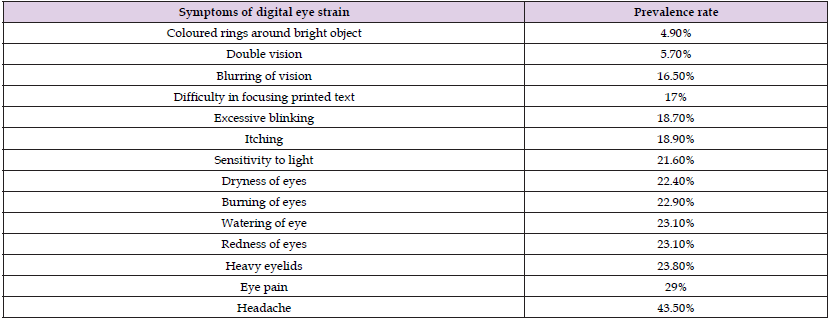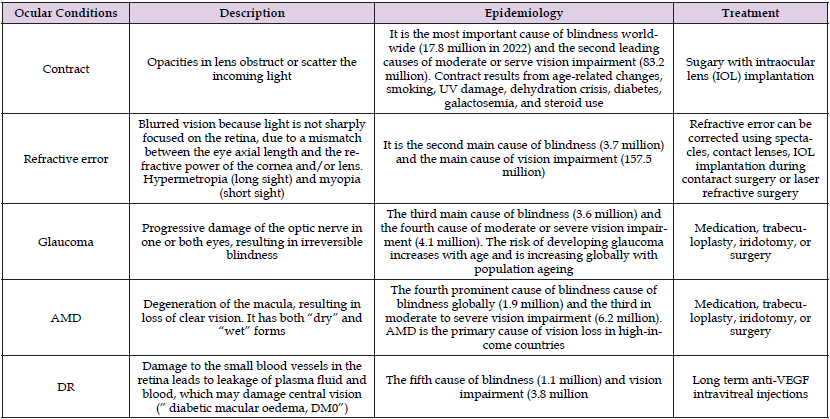Impact Factor : 0.548
- NLM ID: 101723284
- OCoLC: 999826537
- LCCN: 2017202541
Maria Majeed1, Dania Aziz1, Sana Kanwal1, Zoya Ahmed1, Asma Saghir Khan2* and Nazish Zulfiqar3
Received: July 18, 2024; Published: August 08, 2024
*Corresponding author: Asma Saghir Khan, Supervisor, Senior lecturer Food and Nutrition, Department of Home Economics Mirpur University of science and Technology MUST Azad Kashmir, Pakistan
DOI: 10.26717/BJSTR.2024.58.009106
Eyes are the most crucial component of our visual system, the eyes depend on micronutrients including vitamins, carotenoids, trace metals, and omega-3 fatty acids to maintain optimal performance and defense against agemediated and light-induced degenerative diseases. Since the 1980s, the Mediterranean Diet (MedDiet) has gained popularity due to its many health advantages, one of which is improved eye health. In order to reap the greatest health benefits, the MedDiet calls for consuming small amounts of red meat in addition to a diet high in fish, eggs, nuts, legumes, citrus fruits, green vegetables, olives and their derivatives especially olive oil and dairy products in moderation. The antioxidant, anti-inflammatory, and neuroprotective properties of these foods both when used as an ingredient in the dietary regime or as a source of nutritional supplements have shown promising results in the management of chronic degenerative ocular diseases, both in animal models and in human subjects. In this chapter, we will focus on the importance of MedDiet and natural compounds for the visual system and its role in slowing down age-related ocular degeneration.
Keywords: Carotenoid; Trace Metals; Meddiet; Antioxidants; Anti-Inflammatory; Regime; Overwhelming; Ethnic Minorities; Malnourished; Dysfunction; Micronutrients; Malnutrition; Manifestation; Dietary Deficiencies; Suppressing; Amblyopia; Peroxidation; Rhodopsin; Evidence; Natural Substances; Probiotics Aids; Gut Microbiota
Eye health and vision have extensive and overwhelming effects on the overall quality of life, health, education, sustainable development, and even on the economy. Lacking the access to high quality treatment regimens and even to affordable eye care has rendered many people blind or visually impaired. In 2020 an estimated 596 million people in the world had distance vision impairment, out of which 90% of cases could be treated using high-cost treatment regimen. Out of these, 43 million suffered from complete or partial blindness. On the other hand, 510 million people could not improve near vision impairments because they could not afford reading glasses, showing the extremely poor socio-economic conditions in which they live. These patients included all age groups, mostly affecting children and the elderly. In addition, eye diseases were more prevalent in women, ethnic minorities, and people living in rural areas. One of the major factors observed in these patients was that they were malnourished, due to the inadequate food supply because of overall poor socioeconomic conditions.
Diet, being a key lifestyle factor, can exert long-term effects even on ocular health and play a vital role in preventing visual dysfunction, which can lead to permanent visual impairment or blindness and it is estimated to affect 1 billion people worldwide by 2050.
Science is always a two-edged sword with benefits and drawbacks. Even if the use of digital devices across all age groups has increased recently, the Covid-19 pandemic starting in 2020 has caused a sharp increase in both the percentage of users and the amount of time they spend using them. Children in school are compelled to attend lessons virtually via computers or smartphones, and seniors’ social lives have been curtailed due to curfews, which has caused them to become addicted to digital devices and develop digital eye strain. Digital eye strain can cause headaches, blurry vision, dry eyes, and neck and shoulder pain. While digital eye strain, or DES, is less common in India and is only now becoming noticeable, in the West, DES, also known as dry eye disease, was shown to be prevalent in 2016 at a rate of 49.5%. According to a study by (Bahkir, et al. [1]), Table 1 shows the effect of digital gadgets on eye health, particularly during the epidemic curfew.
Table 1: Impact of digital devices on eye health.

Note: Source: Indian Journal of Ophthalmology: November 2020
Keywords: Sword; Drawbacks; Curfew; Digital Eye Strain
Common Eye Conditions that Lead to Visual Impairment: (Table 2) Visual impairment is a result of numerous variables, including age, malnutrition, lifestyle, environment, and genetic abnormalities. A growing number of adults worldwide are experiencing visual impairment and dysfunction, which can be attributed to various ocular disorders such as age-related macular degeneration (AMD), glaucoma, cataracts, dry eye disease (DED), diabetic retinopathy (DR), ocular surface dysfunction (OSD), and refractive errors. This is indicated by the global trend in the population growth index. On the other hand, cerebral visual impairment, uncorrected refractive error, cataract, retinopathy of prematurity, and corneal scarring are the primary causes of blindness and reduced vision in children. Furthermore, a number of ailments, including blepharitis, dry eyes, and allergic conjunctivitis, can cause itching, pain, and discharge in many individuals who do not have visual impairments [2-5] (Table 3).
Table 2: Impact of Nutrients on Eye Function.

Note: Source: Frontier in Nutrition, 2021
Keywords: exudate severity, macular volume, retinal
Table 3: Most prevalent eye conditions causing vision impairment.

Note: Keywords: Age-Related Macular Degeneration; Glaucoma; Contaract; Dry Eye Disease; Diabetic Retinopathy; Ocular Surface Dysfunction; Refractive Errors; Ailments; Blepharitis; Allergic Conjunctivitis.
Diet and Eyes Health: Numerous studies involving large populations have demonstrated the significance of food, particularly micronutrients, in the treatment of age-related eye disorders. Because of these findings, scientists are now concentrating their study on a broad range of nutrients in the treatment of disorders affecting the eyes, including age-related macular degeneration, cataract, glaucoma, dry eye, and retinal ailments (light mediative oxidative damage). The effects of malnutrition on the development of the new-born visual system and the manifestation of ocular diseases in adults due to dietary deficiencies have suggested that nutrition is important not only for the proper development of the visual system but also for enhancing or suppressing the various ocular manifestations that lead to blindness and visual impairment. For example, research has shown that while vitamin E is harmful to retinitis pigmentosa, taking vitamin A in approved dosages has positive effects on the illness. Furthermore, it has been discovered that supplementing with lutein and docosahexaenoic acid (DHA) in addition to vitamin A can postpone retinal degeneration and visual impairment. Similarly, a number of studies have found a connection between xerophthalmia and night blindness and vitamin A insufficiency. Conversely, inadequate consumption or absorption of vitamin B leads to nutritional amblyopia, a condition characterized by impaired vision and decreased visual acuity. Moreover, carotenoids have been shown to enhance eyesight throughout life and prevent retinal and lens deterioration, which in older people can result in AMD and cataracts [6-9].
Natural Molecules: Food has a wealth of vital vitamins, micronutrients, and physiologically active substances that can be crucial in preserving eye health. Table 4 presents a selection of natural compounds and their impact on eye illnesses.
Table 4: The effects of selected nutritional supplements on various ocular manifestations and their food sources.

Note: Keywords: Physiologically; Taurine; Palmitoylethanolamide; Retinitis Pigmentosa.
MedDiet and Eye Health: A healthy lifestyle, demonstrated by a balanced diet and regular exercise, provides an effective preventative measure against the rapidly rising incidence of eye conditions as AMD, cataracts, glaucoma, diabetic retinopathy, dry eye syndrome, and progressive myopia. Providing specific micronutrients in recommended daily levels, such as vitamins, minerals, Omega 3 fatty acids, and carotenoids, promotes general health and has beneficial impacts on the health of the eyes and visual system. But in developing nations, where the majority of people live in poverty and cannot afford dietary supplements, adding these micronutrients to the diet as supplements may cause problems. In this sense, the preferred way to bring healthy nutrients into the body is through diet plans that are within the means of a broad spectrum of socioeconomic groups. 56.5% of cases in recent retrospective clinical research with 7756 participants and a mean age of 71 years demonstrated the positive benefits of the MedDiet on AMD. The findings showed that strictly adhering to the MedDiet decreased the likelihood of developing big drusen and late AMD. In a second prospective study, researchers looked into the relationship between the MedDiet and the incidence of advanced AMD in 4446 European adults 55 years of age and older. They found that subjects who followed the diet had a 41% lower risk of developing AMD than those who did not [10-12].
A nutrient-rich MedDiet that includes whole grains, seafood, vegetables, fruits, legumes, and olive oil can help prevent AMD. Despite the inability of these trials to establish a clear causal association between MedDiet and AMD, they did demonstrate that the total diet, rather than any of its individual components, was responsible for the lower risk of AMD development (Table 5).
Table 5: Dietary patterns as interventions to age-related eye diseases.

Note: Keywords: Dry Eyes Syndrome; Progressive Myopia; Poverty; Drusen; Glaucoma.
An Ideal Ocular Nutritional Supplements: Both patients and medical experts are interested in the potential role that dietary supplements may play in delaying the onset or progression of ocular disease. The purpose of this research is to determine which antioxidants should be included in the optimal ocular nutritional supplement for people who have a family history of glaucoma, cataracts, or age-related macular disease, or who have lifestyle choices that increase their risk of developing these conditions, such as smoking, inadequate diet, or prolonged sun exposure. Additionally, it would be appropriate for people with early-stage age-related eye diseases. Vitamins A and E play functions in preventing lipid peroxidation and producing rhodopsin, respectively, which helps prevent ocular diseases. Studies have shown that vitamin C plays a preventive function in preventing cataracts, and B vitamins have been associated with a lower risk of cataract development. Although beta-carotene has been associated with a higher risk of lung cancer in smokers, it is effective in preventing the development of free radicals. Supplementing with lutein and zeaxanthin has been shown to improve visual function in people with age-related macular degeneration. Zinc, while necessary for the activity of antioxidant enzymes, has been connected to negative effects. Selenium, on the other hand, has been associated with a lower risk of cataract and stimulates the antioxidant enzyme glutathione peroxidase, shielding cell membranes from oxidative damage. We support adding lutein/zeaxanthin, vitamins C and E, to our theoretically optimal ocular nutritional supplement [13,14].
Our eyes play a vital role in our development, well-being, and happiness. It is now established that eating a well-balanced diet helps keep the visual system in good condition and prevents a number of eye issues. Based on scientific evidence, antioxidant and anti-inflammatory natural substances, vitamins, and minerals are important in mitigating and preventing age-related ocular degeneration. As a result, as we age, we need a sufficient amount of healthy fats, fiber, proteins, and carbohydrates in addition to vitamins and minerals to be healthy. Furthermore, taking a sufficient quantity of probiotics aids in the regulation of the gut microbiota, which influences the ocular surface microbiota and guards against a number of ocular illnesses. All of these components together make up the Mediterranean diet, which has great promise as a dietary plan for improved eye care and treatment and should be carefully considered.


